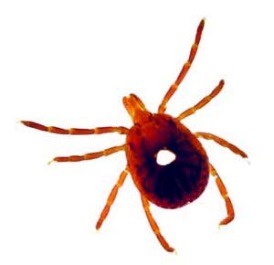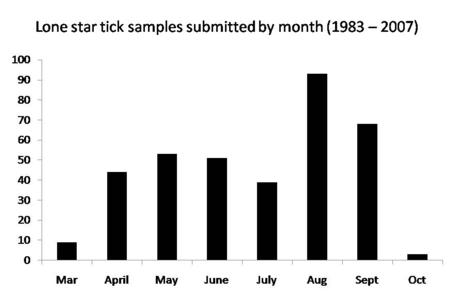The Lone Star Tick in Kentucky
ENTFACT-648: The Lone Star Tick in Kentucky | Download PDF
by Lee Townsend, Extension Entomologist
University of Kentucky College of Agriculture
The lone star tick (Fig. 1) is an important nuisance pest across Kentucky and can be a vector of some diseases. Its most common hosts are wild mammals and ground-nesting birds but these aggressive ticks readily feed on humans and companion animals.

Fig. 1 The female lone star tick has a distinct white spot on its back.
Lone star ticks are active from March through September (Fig 2). Each of its three active stages (larva, nymph, and adult) requires a blood meal.

Fig. 2 Lone star nymphs and adults are active in the spring; larvae or seed ticks are abundant in August and September.
Reactions to substances in the saliva of lone star ticks can cause itching and redness around the bite that may last two weeks or longer (Fig 3.). While bites are irritating, the more serious threat is the transfer certain microorganisms from infected animals to humans as the ticks feed.

Fig. 3 Partially engorged six-legged lone star tick larva, also called “seed ticks” and “turkey mites” on head of a pin. Red spots on the ankle are reactions to tick saliva injected during feeding.
Lone Star Ticks and disease
Lone star ticks can pick up and transmit several diseases from infected animals. Fortunately, the percentage of infected ticks in Kentucky is very low. In addition, infected ticks must feed for several hours before transferring a pathogen. Early detection and prompt removal are important actions that you can take to reduce irritation from tick bites and the potential for acquitting a tick-borne disease.
Let your physician/health care provider know if you are exposed to ticks through work or other outdoor activities and discuss a plan of action.
Human ehrlichiosis is caused by the bacterium Erlichia chaffiensis. The bacterium can be transmitted from infected white-tailed deer to humans and dogs through tick bites. About 30 cases are confirmed in Kentucky each year.
Non-specific symptoms of erlichiosis, including fever, headache, and/or muscle aches, can appear 5 to 10 days after the bite of an infected tick. Additional symptoms may include nausea, vomiting, diarrhea, cough, joint pain, confusion, and occasionally a rash. However, many infected persons attribute mild symptoms to a “summer cold” and do not seek medical attention.
Southern Tick-Associated Rash Illness (STARI)
The causal agent of STARI is unknown. Some people develop a similar expanding "bulls eye" rash as seen with Lyme disease. The rash usually appears within 7 days and can expand to a diameter of 2 inches or greater. There also may be fever, headache, muscle and joint pain, and a feeling of "being tired".
STARI has not been linked to arthritis, neurologic disease, or other chronic symptoms that are seen with Lyme. There is no information on the incidence of STARI in Kentucky. Deer may be the source of the causal agent.
If you have been bitten by a tick or have a known exposure to ticks in the last 30 days and developed an expanding skin rash larger than 2 inches across, you may qualify for a STARI research study. To see if you are eligible to participate, please contact the Centers for Disease Control at tbrstudymailbox@cdc.gov. Provide a phone number and email address so that you may be contacted.
Lyme Disease
The lone star tick is not known to transmit Lyme disease.
Spotted Fevers
The lone star tick does not seem to have any significant role in the transmission of spotted fevers, including Rocky Mountain spotted fever.
Tularemia is bacterial disease of rabbits and rodents that may be transmitted to humans and pets by tick bites. An average of fewer than 2 cases are reported annually in the state.
Red Meat Allergy
Alpha-galactose is a sugar in the saliva of the lone star tick that is injected into the host as the tick feeds. Some victims of tick bites develop strong immune reactions to the sugar. Tick bite victims sensitized to the sugar can have acute allergic reactions within 3 to 6 hours after eating beef, pork, or other red meats.
Personal protection
Tick numbers tend to be highest along edges of wooded areas and in overgrown vegetation.
Follow these steps to protect yourself from ticks:
1. Use repellents. Products containing DEET are particularly effective; picaridin is an alternative. Clothing treatments containing permethrin are advisable when in areas where ticks are suspected or known to be abundant.
2. Check yourself every 2 hours while in areas where ticks are known or likely to be present and very thoroughly after returning home from work or other outdoor activities. Ticks may wander for some time before settling to feed. Often, they can be found and removed before they become attached.

Fig. 4 Lone star ticks commonly attach behind the knees, around the waist, groin, under arms, and on neck and head (indicated by X).
3. Remove attached ticks properly (Fig. 5).
- Use fine-tipped tweezers to grasp the tick as close to the skin’s surface as possible.
- Pull upward with steady, even pressure. Do not twist or jerk the tick; this can cause the mouth-parts to break off and remain in the skin. If this happens, remove the mouthparts with tweezers. If you are unable to remove them easily with clean tweezers, leave them alone and let the skin heal.
After removing the tick, thoroughly clean the bite area and your hands with rubbing alcohol or soap and water.

Fig. 5 Proper tick removal requires a steady, even, upward pull. (Drawing source: CDC)
Never crush a tick with your fingers. Dispose of a live tick by putting it in alcohol, placing it in a sealed bag/container, wrapping it tightly in tape, or flushing it down the toilet.
Additional tips:
- Avoid walking through tall grass and brushy areas along fence lines or adjacent to woods.
- Wear light-colored clothing so ticks are easy to spot. Tuck pants into socks and shirt into pants keep ticks from reaching your skin
- Check pets when they come in from outdoors.
- Take a warm soapy shower after potential tick exposure
- Wash clothing in hot water and detergent - store in sealed bag until it is washed
Tick management
Landscape modifications are necessary for long-term reduction. Lone star ticks prefer overgrown areas, such as woodlot margins or trail edges, where cover protects them from direct sunlight and hot, dry air. These places also provide food and shelter for small and large mammals that ticks use for blood meals.
Wild mammals are the main way that the ticks survive and are moved around in an area. White-tailed deer, raccoons, and striped skunks are important hosts. Eastern cottontail rabbits and Virginia opossums generally have fewer ticks but are more abundant in an area. These animals can carry ticks into yards and back into rural landscapes. Use fencing to restrict animal movement in problem areas, if practical.
Making areas unsuitable for ticks is a sustainable means of managing them. Keep lawns where ticks have been a problem mowed (3” or less). This will lower humidity and raise soil temperatures making conditions unfavorable. It also discourages cover for mice and other small animals that can be hosts for ticks. This is a long-term approach but can reduce tick numbers by about 75%.
Do not attract wildlife or wandering animals that may be carrying ticks. Keep garbage in tightly closed cans and do not leave pet food outdoors for long periods.
Locate play areas for children as far away as possible from the edge of woods or overgrown areas to reduce potential contact with ticks.
Insecticides
Insecticides provide a short-term means of reducing tick numbers until habitat modifications can be made. They are not the answer to long-term control.
Spray 8 to 10 foot swaths along shady areas or margins of woods. In general, there is no need to spray open sunny, mowed areas of turf. Below are examples of some lawn and garden insecticides that are labeled for tick control in lawns. Follow the label direction for mixing and applying the diluted spray.
Example insecticides for tick control:
- Bifenthrin - Ortho Bug B Gon Lawn & Garden Insect Killer
- Cyfluthrin - Bayer Multi-Insect Killer Concentrate
- Cyhalothrin - Spectracide Flea & Tick Killer,
- Permethrin - Dragon Lawn & Garden Protector, Carbaryl Sevin Liquid Insecticide
Ticks indoors
Ticks found indoors on floors, furniture, or beds usually have been carried in accidentally on people or pets. Vacuum areas where ticks have been found and seal the bag in a plastic trash bag and dispose of it. Fortunately, it is too dry for lone star ticks to survive long in buildings.
Wash pet bedding in hot soapy water to kill ticks that may be present.
Ticks on pets
Outdoor pets that roam freely can easily and repeatedly pick up ticks and carry them into the yard or home. Management of ticks on pets is an important part of dealing with chronic or severe tick problems.
- Check with your veterinarian for advice on preventive tick control products.
- Groom animals carefully and check for ticks before allowing them indoors.
- Keep pets off furniture where attached ticks can drop off.
- Check pet sleeping areas routinely for ticks.
Issued: 01/09
Revised 6/18
CAUTION! Pesticide recommendations in this publication are registered for use in Kentucky, USA ONLY! The use of some products may not be legal in your state or country. Please check with your local county agent or regulatory official before using any pesticide mentioned in this publication.
Of course, ALWAYS READ AND FOLLOW LABEL DIRECTIONS FOR SAFE USE OF ANY PESTICIDE!
Images: Lee Townsend, University of Kentucky Entomology.
